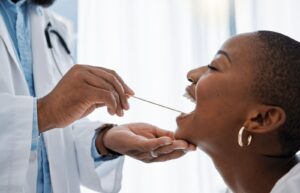
Oral and oropharyngeal cancers are serious health concerns that affect millions worldwide. Early detection is crucial for successful treatment, but many people are unaware of the signs, symptoms, and risk factors associated with these diseases. This comprehensive guide will focus on the complexities of oral and oropharyngeal cancers, providing valuable insights into their causes, symptoms, prevention strategies, and risk factors.
What are Oral and Oropharyngeal Cancers?
Oral cancer, a type of head and neck cancer, develops in the tissues of the oral cavity, including the lips, tongue, gums, inner lining of the cheeks and lips (abnormal cells), the floor of the mouth, and hard palate (the bony front part of the roof of the mouth).
On the other end, oropharyngeal cancer develops in the oropharynx, the middle part of the throat, including the soft palate, tonsils, back of the tongue, and throat walls (pharynx), which can also be affected by cancer.
Recognizing the Early Warning Signs
Early detection of oral and oropharyngeal cancers is crucial. Monitor any unusual mouth or throat changes and consult a healthcare professional if symptoms persist for over two weeks:
-
- Non-healing Sores: Sores that don’t heal, bleed easily, or have white/red patches need medical evaluation.
-
- Lumps and Thickenings: Unusual lumps in the cheek, tongue, or mouth should be checked.
-
- White or Red Patches: Potential precancerous lesions on gums, tongue, or mouth lining require assessment.
-
- Persistent Sore Throat: A sore throat with swallowing difficulty may signal oropharyngeal cancer.
-
- Difficulty Chewing or Swallowing: Dysphagia can indicate oral or oropharyngeal cancers.
-
- Hoarseness or Voice Changes: Persistent voice changes should be examined.
-
- Numbness: Tongue or mouth numbness may result from nerve involvement.
- Ear Pain: Unexplained ear pain can signal cancer spreading to lymph nodes.
Prevention Strategies
While not all cases of oral and oropharyngeal cancers are preventable, you can significantly reduce your risk by avoiding tobacco, moderating alcohol consumption, getting vaccinated against HPV, maintaining good oral hygiene through regular brushing, flossing, and dental checkups, and following a healthy diet rich in fruits, vegetables, and whole grains.
Risk Factors
Several factors can increase the risk of oral and oropharyngeal cancers, including tobacco use, heavy alcohol consumption (especially with tobacco), HPV infection (particularly HPV 16), age (risk rises after 55), gender (men are more affected), race and ethnicity (higher rates in some groups), a weakened immune system (like HIV/AIDS), genetic predisposition, and excessive sun exposure, which heightens the risk of lip cancer.
Taking Charge of Your Oral Health
Oral and oropharyngeal cancers are serious, but early detection improves outcomes. Stay aware of symptoms, take preventive steps, and know your risks. Regular dental checkups can catch early signs, so consult a doctor if you notice any changes. Knowledge is key to protecting your health.


 Powered by
Powered by